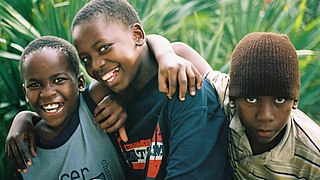
A child is a human being between the stages of birth and puberty, or between the developmental period of infancy and puberty. It may also refer to an unborn human being. The legal definition of child generally refers to a minor, otherwise known as a person younger than the age of majority. Children generally have fewer rights and responsibilities than adults. They are classed as unable to make serious decisions.

Early childhood education (ECE), also known as nursery education, is a branch of education theory that relates to the teaching of children from birth up to the age of eight. Traditionally, this is up to the equivalent of third grade. ECE is described as an important period in child development.
Psychological trauma is an emotional response caused by severe distressing events such as accidents, violence, sexual assault, terror, or sensory overload.

A humanitarian crisis is defined as a singular event or a series of events that are threatening in terms of health, safety or well-being of a community or large group of people. It may be an internal or external conflict and usually occurs throughout a large land area. Local, national and international responses are necessary in such events.
Psychological resilience is the ability to cope mentally and emotionally with a crisis, or to return to pre-crisis status quickly.

The right to education has been recognized as a human right in a number of international conventions, including the International Covenant on Economic, Social and Cultural Rights which recognizes a right to free, primary education for all, an obligation to develop secondary education accessible to all with the progressive introduction of free secondary education, as well as an obligation to develop equitable access to higher education, ideally by the progressive introduction of free higher education. In 2021, 171 states were parties to the Covenant.
Childhood trauma is often described as serious adverse childhood experiences (ACEs). Children may go through a range of experiences that classify as psychological trauma; these might include neglect, abandonment, sexual abuse, emotional abuse, and physical abuse, witnessing abuse of a sibling or parent, or having a mentally ill parent. These events have profound psychological, physiological, and sociological impacts and can have negative, lasting effects on health and well-being such as unsocial behaviors, attention deficit hyperactivity disorder (ADHD), and sleep disturbances. Similarly, children whose mothers have experienced traumatic or stressful events during pregnancy have an increased risk of mental health disorders and other neurodevelopmental disorders.
An at-risk student is a term used in the United States to describe a student who requires temporary or ongoing intervention in order to succeed academically. At risk students, sometimes referred to as at-risk youth or at-promise youth, are also adolescents who are less likely to transition successfully into adulthood and achieve economic self-sufficiency. Characteristics of at-risk students include emotional or behavioral problems, truancy, low academic performance, showing a lack of interest for academics, and expressing a disconnection from the school environment. A school's effort to at-risk students is essential. For example, a study showed that 80% to 87% of variables that led to a school's retention are predictable with linear modeling. In January 2020, Governor Newsom of California changed all references to "at-risk" to "at-promise" in the California Penal Codes.
Life skills are abilities for adaptive and positive behavior that enable humans to deal effectively with the demands and challenges of life. This concept is also termed as psychosocial competency. The subject varies greatly depending on social norms and community expectations but skills that function for well-being and aid individuals to develop into active and productive members of their communities are considered as life skills.
Child migration or "children in migration or mobility" is the movement of people ages 3–18 within or across political borders, with or without their parents or a legal guardian, to another country or region. They may travel with or without legal travel documents. They may arrive to the destination country as refugees, asylum seekers, or economic migrants.

Nearly half of all refugees are children, and almost one in three children living outside their country of birth is a refugee. These numbers encompass children whose refugee status has been formally confirmed, as well as children in refugee-like situations.
Global citizenship education (GCED) is a form of civic learning that involves students' active participation in projects that address global issues of a social, political, economic, or environmental nature. The two main elements of GCE are 'global consciousness'; the moral or ethical aspect of global issues, and 'global competencies', or skills meant to enable learners to participate in changing and developing the world. The promotion of GCE was a response by governments and NGOs to the emergence of supranational institution, regional economic blocs, and the development of information and communications technologies. These have all resulted in the emergence of a more globally oriented and collaborative approach to education. GCE addresses themes such as peace and human rights, intercultural understanding, citizenship education, respect for diversity and tolerance, and inclusiveness.

Children of migrant workers struggle to achieve the same level of educational success as their peers. Relocation causes discontinuity in education, which causes migrant students to progress slowly through school and drop out at high rates. Additionally, relocation has negative social consequences on students: isolation from peers due to cultural differences and language barriers. Migrant children, defined as those who relocate because of involvement with agriculture-related industries or other seasonal work, are also at a disadvantage because the majority live in extreme poverty and must work with their parents to support their families. These barriers to equal educational attainment for children of migrant workers are present in countries all over the world. Although the inequality in education remains pronounced, government policies, non-governmental organizations, non-profits, and social movements are working to reverse its effects.
Early childhood trauma refers to various types of adversity and traumatic events experienced during the early years of a person's life. This is deemed the most critical developmental period in human life by psychologists. A critical period refers to a sensitive time during the early years of childhood in which children may be more vulnerable to be affected by environmental stimulation. These traumatic events can include serious sickness, natural disasters, family violence, sudden separation from a family member, being the victim of abuse, or suffering the loss of a loved one. Traumatic experiences in early childhood can result in severe consequences throughout adulthood, for instance developing post-traumatic stress disorder, depression, or anxiety. Negative childhood experiences can have a tremendous impact on future violence victimization and perpetration, and lifelong health and opportunity. However, not all children who are exposed to negative stimuli in early childhood will be affected severely in later life; some children come out unscathed after being faced with traumatic events, which is known as resilience. Many factors can account for the invulnerability displayed by certain children in response to adverse social conditions: gender, vulnerability, social support systems, and innate character traits. Much of the research in this area has referred to the Adverse Childhood Experiences Study (ACE) study. The ACE study found several protective factors against developing mental health disorders, including mother-child relations, parental health, and community support. However, having adverse childhood experiences creates long-lasting impacts on psychosocial functioning, such as a heightened awareness of environmental threats, feelings of loneliness, and cognitive deficits. Individuals with ACEs are more prone to developing severe symptoms than individuals in the same diagnostic category.

Children in emergencies and conflicts constitutes the effects of situations that pose detrimental risks to the health, safety, and well-being of children. There are many different kinds of conflicts and emergencies, for example, violence, armed conflicts, war, natural disasters, etc. Approximately 13 million children are displaced by armed conflicts and violence around the world. Where violent conflicts are the norm, the lives of young children are significantly disrupted and their families have great difficulty in offering the sensitive and consistent care that young children need for their healthy development. Studies on the effect of emergencies and conflict on the physical and mental health of children between birth and 8 years old show that where the disaster is natural, the rate of PTSD occurs in anywhere from 3 to 87 per cent of affected children. However, rates of PTSD for children living in chronic conflict conditions varies from 15 to 50 per cent as evidenced in the following countries: Iran, Iraq, Israel, Kuwait, Lebanon, Palestine, Rwanda, South Africa, and Sudan.

Climate change education (CCE) is education that aims to address and develop effective responses to climate change. It helps learners understand the causes and consequences of climate change, prepares them to live with the impacts of climate change and empowers learners to take appropriate actions to adopt more sustainable lifestyles. Climate change and climate change education are global challenges that can be anchored in the curriculum in order to provide local learning and widen up mindset shits on how climate change can be mitigated. In such as case CCE is more than climate change literacy but understanding ways of dealing with climate
Newcomer education is the specialized teaching of refugees, migrants, asylees, and immigrants who have resettled in a host country, with the goal of providing the knowledge and skills necessary to integrate into their country of refuge. Education is the primary way by which newcomers can adjust to the linguistic, social, and cultural environments of their new communities. Newcomer education aims to empower newcomers with a sense of self-efficacy and social integration, as well as giving them the skills to pursue employment or higher education. Newcomer education also aims to help address trauma, culture shock, and other negative effects of forced displacement. Education for newcomers can provide long-term prospects for stability of individuals, communities, countries and global society.

The COVID-19 pandemic affected educational systems across the world. The number of cases of COVID-19 started to rise in March 2020 and many educational institutions and universities closed. Most countries decided to temporarily close educational institutions in order to reduce the spread of COVID-19. UNESCO estimates that at the height of the closures in April 2020, national educational shutdowns affected nearly 1.6 billion students in 200 countries: 94% of the student population and one-fifth of the global population. Closures are estimated to have lasted for an average of 41 weeks. They have had significant negative effects on student learning, which are predicted to have substantial long-term implications for both education and earnings. During the pandemic, education budgets and official aid program budgets for education have decreased.

A systematic review notes that children with COVID-19 have milder effects and better prognoses than adults. However, children are susceptible to "multisystem inflammatory syndrome in children" (MIS-C), a rare but life-threatening systemic illness involving persistent fever and extreme inflammation following exposure to the SARS-CoV-2 virus.

The COVID-19 pandemic has had a considerable impact on female education. Female education relates to the unequal social norms and the specific forms of discrimination that girls face. In 2018, 130 million girls worldwide were out of school, and only two out of three girls were enrolled in secondary education. The COVID-19 pandemic may further widen the gaps and threatens to disrupt the education of more than 11 million girls. In addition, girls are less likely to have access to the Internet and online learning.










